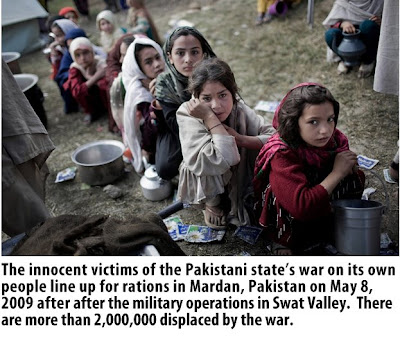
The coming to power of Barack Obama, while making some jubilant, has others asking questions, especially in South Asia. Obama’s Pakistan Strategy is rooted in the U.S.’s ‘War on Terror.’ According to Obama’s National Security Advisor, General James Jones, the American ‘strategy now starts with…[an] attainable goal which is to disrupt, dismantle, and prevent al-Qaida from being able to operate in its safe havens – not only al-Qaida, but all forms of terrorism that would seek to destabilize our countries….’ He goes on to say, ‘Our strategy focuses more intensively on Pakistan than in the past, and this is normal, because it’s a newer problem.’
It is not difficult to see that Obama’s wider strategy for Pakistan has some parallels to the Bush administration’s strategy in Iraq. It is a strategy aimed at extending U.S. imperialism first through military operations and destruction of any existing social and economic infrastructure, only to be replaced by ‘reconstruction’ efforts that will afford lucrative contracts for rebuilding to large economic monopolies.
As Gen. James Jones reiterated on behalf of Obama, ‘a campaign against extremism will not succeed with bullets or bombs alone. As a part of this strategy, we’ll devote significantly more resources to the civilian efforts in both Afghanistan and Pakistan. The President will submit a budget that includes indispensable investments in our State Department and foreign assistance programs. These investments relieve the burden on our troops and contribute directly to our safety and security [sic].’
According to the U.S. Agency for International Development (USAID) fact sheet on the emergency situation in Pakistan, as of May 27, 2009, there are approximately 2.7 million internally displaced persons in the Northwest Frontier Province (NWFP) of Pakistan. NWFP is where military operations are concentrated and where the Taliban is said to have strong influence.
Under intense pressure from the U.S. and other imperialist countries such as Britain, Pakistan cancelled a peace deal that they had concluded with the Taliban and intensified military operations. There were concerns over the provision in the deal for the use of Sharia law and its impact on Pakistani women. U.S. Secretary of State, Hillary Clinton, said of the deal that Pakistan posed a ‘mortal threat’ to the world by abdicating to the Taliban. Concern for the rights of women being used as a justification for imperialist war is not a new strategy of American imperialism. It is reminiscent of U.S. policy in Iraq.

The first phase of the American strategy of building a Pakistani client state is of course to use the new Pakistani leadership and the Pakistani military to carry out offensives against the Taliban. The military continues to attack Taliban strongholds from the air, and using artillery and mortars has caused widespread destruction and a mounting toll of civilian casualties. Mingora, the district capital of the Swat Valley, which is still under Taliban control, has been a main target of the army’s operations. Troops have seized key positions around the town, all exit roads have been sealed and electricity, water and gas supplies have been cut off.
In addition, the U.S. is carrying out drone attacks in Pakistan. However, this strategy is backfiring as U.S. Army Chief in Pakistan, David Kilcullen has pointed out. He noted that these U.S. actions are highly unpopular amongst the civilian population and are leading to the mounting of hostile feelings amongst Pakistani citizens toward the U.S.
There is no possibility that the U.S. strategy for Pakistan will lead to the betterment of conditions for Pakistanis. If the U.S.’s Pakistan Strategy plays out according to plan, Pakistan will turn into another U.S. “reconstruction” project like the devastated and shattered occupied Iraq.
Comments